Pull-Up and Chin-Up Grip Guide: How Hand Placement Changes the Exercises
Pull-Ups are one of the best exercises out there. They’re simple, requiring only a sturdy bar and your own body weight. But they are effective. The simplicity of the exercise is a big reason for its popularity, and Pull-Ups are one of the most common exercises around the world. Fitness centers, middle school gyms, playgrounds, doorways, prison cells—Pull-Ups can be done almost anywhere.
Pull-Ups are also great for measuring your strength-to-bodyweight ratio. Meatheads built like rhinos are often incapable of performing multiple Pull-Ups, whereas lean, mean athletic types can usually perform multiple sets.
Yes, Pull-Ups are extremely popular, but most people are unaware of an important factor—hand position. The most significant variation of hand position is between holding the bar with an overhand grip or an underhand grip.
Although these characterizations are not universally accepted, with an overhand grip, the exercise is commonly known as a Pull-Up, and an underhand grip makes it a Chin-Up. But lots of other hand positions can be used on a Pull-Up bar—wide, narrow, neutral, mixed. Each variation affects the body differently, so knowing when and how to use each grip is a big plus.
STACK talked with Craig Weller, exercise specialist at Precision Nutrition and co-owner of Rogue Performance and Barefoot Fitness, to learn more about how grip position affects these classic exercises.
Pull-Up
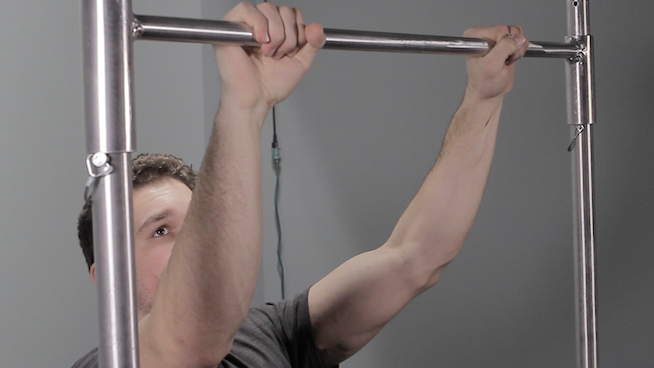
Traditional Pull-Up grip
Position: Overhand or “pronated” grip, hands slightly wider than shoulder-width apart
The common Pull-Up is the classic exercise nearly everyone is familiar with. It challenges the lats, biceps, pecs and middle back. It’s a great all-around exercise for building mass and increasing upper-body strength.
Weller says, “A good Pull-Up is done with the hands just outside shoulder-width.” When done correctly, it is a safe exercise, but swinging (such as is done with a Kipping Pull-Up) can increase the risk of shoulder injuries.
The Pull-Up targets the lower trapezius (the middle back) and the latimuss dorsi more effectively than the Chin-Up. If you’re looking to build a beefy back, Pull-Ups are a strong choice. Pull-Ups are also considered more difficult than Chin-Ups, so you should first master Chin-Up form before trying Pull-Ups.
RELATED: Do Your First Pull-Up With This Simple Workout. Guaranteed.
Chin-Up
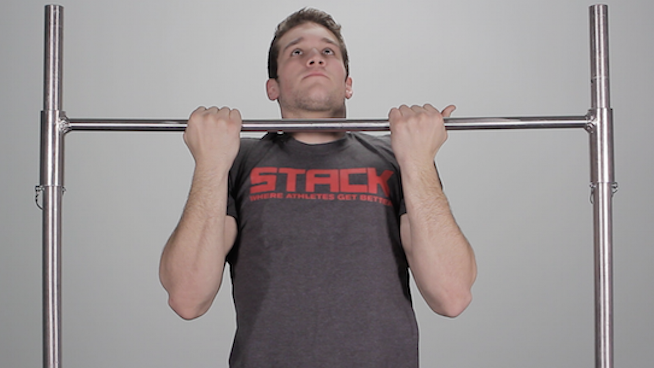
Traditional Chin-Up grip
Position: Underhand or “supinated” grip, hands about shoulder-width apart
What’s better, the Chin-Up or the Pull-Up? It’s a question you hear all the time. Both are great bodyweight exercises, and one isn’t necessarily “better” than the other. The Chin-Up more effectively targets the biceps brachii, while the Pull-Up more effectively targets the lower trapezius and latissimus dorsi. Weller says, “The Chin-Up allows for better biceps recruitment, but shifts some emphasis away from the upper back.”
Chin-Up hand position makes it easier for the biceps and pecs to take over the movement, which is why people often find them easier than Pull-Ups.
“Pull-Ups put less mechanical emphasis on the biceps, more on the upper back and make it harder for the pecs to take over when done properly. People tend to find them more difficult than Chin-Ups for this reason,” Weller says. If you’re looking to emphasize your biceps or cannot yet perform Pull-Ups with regularity, starting with Chin-Ups makes sense.
RELATED: Pull-Up or Chin-Up: Which is Better?
Neutral Grip Pull-Up
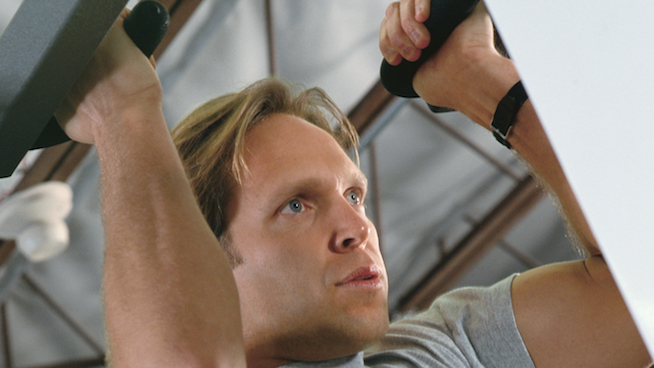
Neutral Grip Pull-Up
Position: Palms facing each other, hands about shoulder-width apart
The Neutral Grip Pull-Up is another great variation, but it does requires a set of parallel handles, which may not be attached to the Pull-Up bar at some commercial gyms. If your gym has the right equipment, you’re in luck. Many people find that the neutral grip puts the least amount of stress on the shoulders, which makes it a good choice if you’ve had shoulder issues in the past. “The neutral grip allows for more natural rotational motion at the wrists and shoulders,” Weller says.
The neutral grip also heavily works your brachialis—a muscle in the biceps that pushes up the biceps brachii and makes your arms look bigger. It’s the muscle that can turn your peashooters into bonafide guns. Neutral Grip Pull-Ups are usually found in the middle ground between the more challenging Pull-Up and the less difficult Chin-Up.
Close Grip Pull-Up/Chin-Up

Close Grip Pull-Up
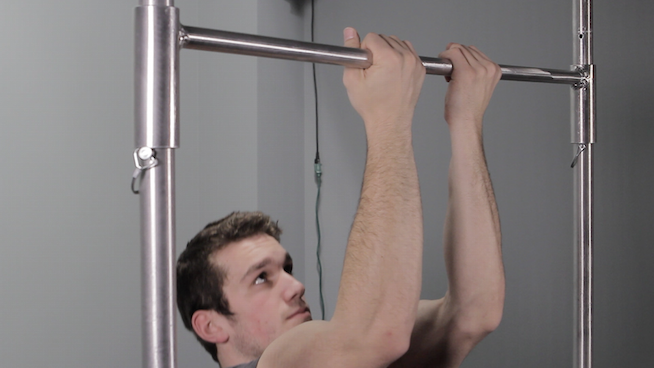
Close Grip Chin-Up
Position: Hands inside shoulder-width
When performing Pull-Ups or Chin-Ups, moving your hands close together leads to greater pec activation. Weller says, “The narrower the grip, the more your pecs are able to kick in. This is why people tend to grip pretty narrow for Weighted Chin-Ups. Their pecs are stronger than their back, so a narrow grip allows them to use more weight.”
If you’re looking to engage more of your pecs with your Pull-Up or Chin-Up, you could go with a narrow grip. However, Weller believes most people get plenty of pec involvement from the standard grip. He says, “For the most part, people should stick to the standard grip, which is right around shoulder-width. Their pecs are probably getting enough emphasis as it is.”
Wide Grip Pull-Up/Chin-Up
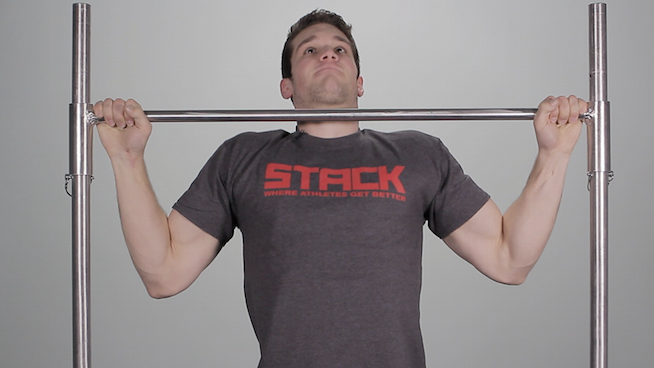
Wide Grip Pull-Up
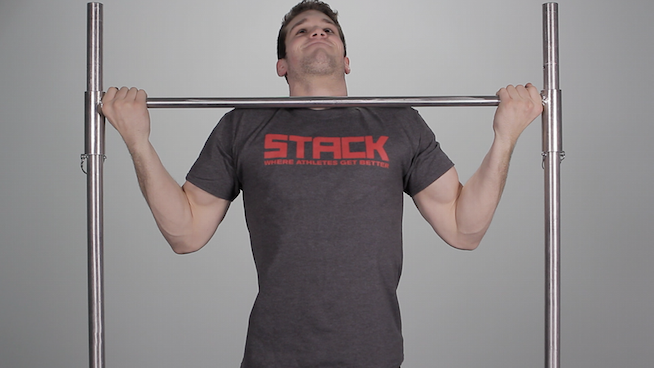
Wide Grip Chin-Up
Position: Hands five inches wider than shoulder-width or beyond
Many people believe the wider their grip, the more they’re activating their lats. Basically, a wider grip builds a wider back. But this isn’t true. “It’s not really necessary to go wider than the standard grip. If you’re trying to get stronger and have healthy shoulders, stick to a standard grip, just outside shoulder-width. A wider grip makes it harder for the pecs to get involved, but it also changes the leverage and makes it harder for you to bring your shoulder blades together and down, so it’s not a good idea for most people,” Weller says.
Due to its relative lack of pec involvement, the wide grip Pull-Up or Chin-Up is extra challenging for most people—despite the fact that it severely limits the range of motion of the exercise. A wide grip can also put more stress on the shoulders, making it a riskier variation.
Mixed Grip Pull-Up

Mixed Grip Pull-Up
Position: One hand supinated, one hand pronated at slightly wider than shoulder-width
The Mixed Grip Pull-Up is just what it sounds like—one hand in an overhand grip, the other underhand. This position allows for improved grip strength over other variations, making it a solid option for heavily weighted repetitions. Other than that, it works the same muscles as the standard Pull-Up and Chin-Up. “The muscular involvement is similar to the basic ways of doing it,” Weller says.
If your grip strength is preventing you from throwing on a heavy chain or weighted vest and knocking out Pull-Ups or Chin-Ups, try the mixed grip. Just be sure to switch things up so you perform the same number of overhand and underhand reps for both hands. This will help you avoid muscle imbalances.
Towel Pull-Up
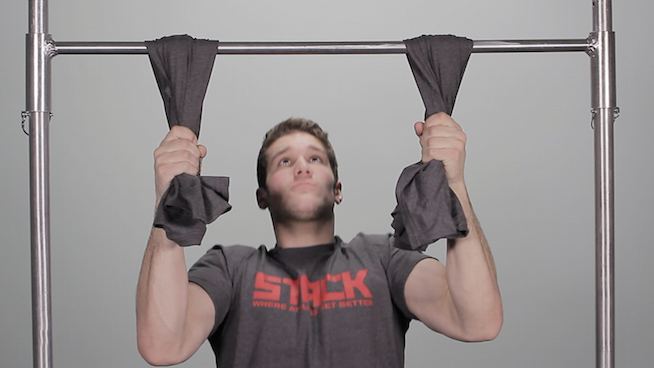
Towel Pull-Up
Position: Hands clutching towels which are about shoulder-width apart
This grip variation will blast your forearms like nobody’s business. To perform Towel Grip Pull-Ups, you need a couple of strong, sturdy towels—not your old, beat-up gym towel with a bunch of holes in it.
Loop the towels around the Pull-Up bar a bit wider than shoulder-width apart. Grab the base of the towels and perform Pull-Ups as you normally would. The added challenge of holding onto the towels will improve your grip, and the added instability will force your core to kick into overdrive.
RECOMMENDED FOR YOU
MOST POPULAR
Pull-Up and Chin-Up Grip Guide: How Hand Placement Changes the Exercises
Pull-Ups are one of the best exercises out there. They’re simple, requiring only a sturdy bar and your own body weight. But they are effective. The simplicity of the exercise is a big reason for its popularity, and Pull-Ups are one of the most common exercises around the world. Fitness centers, middle school gyms, playgrounds, doorways, prison cells—Pull-Ups can be done almost anywhere.
Pull-Ups are also great for measuring your strength-to-bodyweight ratio. Meatheads built like rhinos are often incapable of performing multiple Pull-Ups, whereas lean, mean athletic types can usually perform multiple sets.
Yes, Pull-Ups are extremely popular, but most people are unaware of an important factor—hand position. The most significant variation of hand position is between holding the bar with an overhand grip or an underhand grip.
Although these characterizations are not universally accepted, with an overhand grip, the exercise is commonly known as a Pull-Up, and an underhand grip makes it a Chin-Up. But lots of other hand positions can be used on a Pull-Up bar—wide, narrow, neutral, mixed. Each variation affects the body differently, so knowing when and how to use each grip is a big plus.
STACK talked with Craig Weller, exercise specialist at Precision Nutrition and co-owner of Rogue Performance and Barefoot Fitness, to learn more about how grip position affects these classic exercises.
Pull-Up

Traditional Pull-Up grip
Position: Overhand or “pronated” grip, hands slightly wider than shoulder-width apart
The common Pull-Up is the classic exercise nearly everyone is familiar with. It challenges the lats, biceps, pecs and middle back. It’s a great all-around exercise for building mass and increasing upper-body strength.
Weller says, “A good Pull-Up is done with the hands just outside shoulder-width.” When done correctly, it is a safe exercise, but swinging (such as is done with a Kipping Pull-Up) can increase the risk of shoulder injuries.
The Pull-Up targets the lower trapezius (the middle back) and the latimuss dorsi more effectively than the Chin-Up. If you’re looking to build a beefy back, Pull-Ups are a strong choice. Pull-Ups are also considered more difficult than Chin-Ups, so you should first master Chin-Up form before trying Pull-Ups.
RELATED: Do Your First Pull-Up With This Simple Workout. Guaranteed.
Chin-Up

Traditional Chin-Up grip
Position: Underhand or “supinated” grip, hands about shoulder-width apart
What’s better, the Chin-Up or the Pull-Up? It’s a question you hear all the time. Both are great bodyweight exercises, and one isn’t necessarily “better” than the other. The Chin-Up more effectively targets the biceps brachii, while the Pull-Up more effectively targets the lower trapezius and latissimus dorsi. Weller says, “The Chin-Up allows for better biceps recruitment, but shifts some emphasis away from the upper back.”
Chin-Up hand position makes it easier for the biceps and pecs to take over the movement, which is why people often find them easier than Pull-Ups.
“Pull-Ups put less mechanical emphasis on the biceps, more on the upper back and make it harder for the pecs to take over when done properly. People tend to find them more difficult than Chin-Ups for this reason,” Weller says. If you’re looking to emphasize your biceps or cannot yet perform Pull-Ups with regularity, starting with Chin-Ups makes sense.
RELATED: Pull-Up or Chin-Up: Which is Better?
Neutral Grip Pull-Up

Neutral Grip Pull-Up
Position: Palms facing each other, hands about shoulder-width apart
The Neutral Grip Pull-Up is another great variation, but it does requires a set of parallel handles, which may not be attached to the Pull-Up bar at some commercial gyms. If your gym has the right equipment, you’re in luck. Many people find that the neutral grip puts the least amount of stress on the shoulders, which makes it a good choice if you’ve had shoulder issues in the past. “The neutral grip allows for more natural rotational motion at the wrists and shoulders,” Weller says.
The neutral grip also heavily works your brachialis—a muscle in the biceps that pushes up the biceps brachii and makes your arms look bigger. It’s the muscle that can turn your peashooters into bonafide guns. Neutral Grip Pull-Ups are usually found in the middle ground between the more challenging Pull-Up and the less difficult Chin-Up.
Close Grip Pull-Up/Chin-Up

Close Grip Pull-Up

Close Grip Chin-Up
Position: Hands inside shoulder-width
When performing Pull-Ups or Chin-Ups, moving your hands close together leads to greater pec activation. Weller says, “The narrower the grip, the more your pecs are able to kick in. This is why people tend to grip pretty narrow for Weighted Chin-Ups. Their pecs are stronger than their back, so a narrow grip allows them to use more weight.”
If you’re looking to engage more of your pecs with your Pull-Up or Chin-Up, you could go with a narrow grip. However, Weller believes most people get plenty of pec involvement from the standard grip. He says, “For the most part, people should stick to the standard grip, which is right around shoulder-width. Their pecs are probably getting enough emphasis as it is.”
Wide Grip Pull-Up/Chin-Up

Wide Grip Pull-Up

Wide Grip Chin-Up
Position: Hands five inches wider than shoulder-width or beyond
Many people believe the wider their grip, the more they’re activating their lats. Basically, a wider grip builds a wider back. But this isn’t true. “It’s not really necessary to go wider than the standard grip. If you’re trying to get stronger and have healthy shoulders, stick to a standard grip, just outside shoulder-width. A wider grip makes it harder for the pecs to get involved, but it also changes the leverage and makes it harder for you to bring your shoulder blades together and down, so it’s not a good idea for most people,” Weller says.
Due to its relative lack of pec involvement, the wide grip Pull-Up or Chin-Up is extra challenging for most people—despite the fact that it severely limits the range of motion of the exercise. A wide grip can also put more stress on the shoulders, making it a riskier variation.
Mixed Grip Pull-Up

Mixed Grip Pull-Up
Position: One hand supinated, one hand pronated at slightly wider than shoulder-width
The Mixed Grip Pull-Up is just what it sounds like—one hand in an overhand grip, the other underhand. This position allows for improved grip strength over other variations, making it a solid option for heavily weighted repetitions. Other than that, it works the same muscles as the standard Pull-Up and Chin-Up. “The muscular involvement is similar to the basic ways of doing it,” Weller says.
If your grip strength is preventing you from throwing on a heavy chain or weighted vest and knocking out Pull-Ups or Chin-Ups, try the mixed grip. Just be sure to switch things up so you perform the same number of overhand and underhand reps for both hands. This will help you avoid muscle imbalances.
Towel Pull-Up

Towel Pull-Up
Position: Hands clutching towels which are about shoulder-width apart
This grip variation will blast your forearms like nobody’s business. To perform Towel Grip Pull-Ups, you need a couple of strong, sturdy towels—not your old, beat-up gym towel with a bunch of holes in it.
Loop the towels around the Pull-Up bar a bit wider than shoulder-width apart. Grab the base of the towels and perform Pull-Ups as you normally would. The added challenge of holding onto the towels will improve your grip, and the added instability will force your core to kick into overdrive.










